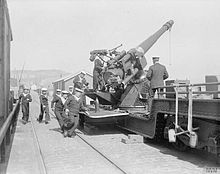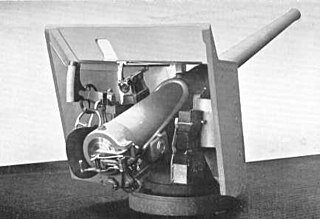| QF 6 inch 40 calibre naval gun 15 cm/40 (6") 41st Year Type | |
|---|---|
Typical naval deck mounting. An early long cartridge case for gunpowder propellant is upended at bottom left, a shell stands next to the cartridge. | |
| Type | Naval gun Coast defence gun |
| Place of origin | United Kingdom licence-produced in Japan |
| Service history | |
| In service | 1892–1945 |
| Used by | Royal Navy Imperial Japanese Navy Chilean Navy Italian Navy Argentine Navy United States Romanian Navy |
| Wars | Russo-Japanese War World War I World War II |
| Production history | |
| Manufacturer | Elswick Ordnance Company Royal Arsenal, Woolwich |
| Specifications | |
| Weight | 6.6 tons |
| Barrel length | 240 inches (6.096 m) bore |
| Shell | 100 pounds (45 kg) QF, separate cartridge and shell |
| Elevation | -5 / +20 degrees |
| Traverse | +150 / -150 degrees |
| Rate of fire | 5-7 rounds per minute |
| Muzzle velocity | 2,154 feet per second (657 m/s) [1] 820 feet per second (250 m/s) for anti-submarine shells |
| Effective firing range | 10,000 yards (9,140 m) at 20°elevation; 15,000 yards (13,700 m) at 28°elevation |
The QF 6 inch 40 calibre naval gun (Quick-Firing) was used by many United Kingdom-built warships around the end of the 19th century and start of the 20th century.
Contents
- Design
- QF technology
- Recoil system
- UK service
- Royal Navy service
- Second Boer War land service
- Coast defence gun
- World War I anti-aircraft gun
- Conversion to 8 inch (203 mm) howitzer
- Italian naval service
- Japanese naval service
- Romanian naval service
- US service
- Surviving examples
- See also
- Weapons of comparable role, performance and era
- Notes
- References
- Bibliography
- External links
In UK service it was known as the QF 6 inch Mk I, II, III guns. [note 1] As the 15 cm/40 (6") 41st Year Type naval gun it was used for pre-dreadnought battleships, armoured cruisers and protected cruisers of the early Imperial Japanese Navy built in UK and European shipyards. It was also the heaviest gun ever carried by a pre-Cold War destroyer.

Pre-dreadnought battleships were sea-going battleships built between the mid- to late 1880s and 1905, before the launch of HMS Dreadnought. Pre-dreadnoughts replaced the ironclad battleships of the 1870s and 1880s. Built from steel, and protected by hardened steel armour, pre-dreadnought battleships carried a main battery of very heavy guns in barbettes supported by one or more secondary batteries of lighter weapons. They were powered by coal-fuelled triple-expansion steam engines.

The Imperial Japanese Navy was the navy of the Empire of Japan from 1868 until 1945, when it was dissolved following Japan's surrender in World War II. The Japan Maritime Self-Defense Force (JMSDF) was formed after the dissolution of the IJN.

The Cold War was a period of geopolitical tension between the Soviet Union with its satellite states, and the United States with its allies after World War II. A common historiography of the conflict begins between 1946, the year U.S. diplomat George F. Kennan's "Long Telegram" from Moscow cemented a U.S. foreign policy of containment of Soviet expansionism threatening strategically vital regions, and the Truman Doctrine of 1947, and ending between the Revolutions of 1989, which ended communism in Eastern Europe, and the 1991 collapse of the USSR, when nations of the Soviet Union abolished communism and restored their independence. The term "cold" is used because there was no large-scale fighting directly between the two sides, but they each supported major regional conflicts known as proxy wars. The conflict split the temporary wartime alliance against Nazi Germany and its allies, leaving the USSR and the US as two superpowers with profound economic and political differences.






























